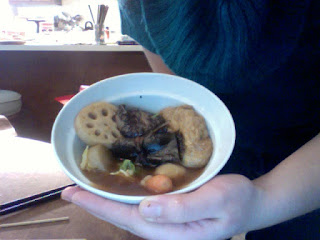I know the picture of this soup isn't great. I had to take it with the camera on my laptop because I did not bring my legit camera home with me for Christmas. I made this soup the day after Christmas because I wasn't going to be with my family for New Years day. Since my grandmother passed away last year, that was the first year we did not do new years soup at her house. We wanted to bring that tradition back so I made it this year for them, and it was almost as good as my grandmother made it.
Ozoni is unique. No two soups will ever be the same because every region of Japan and every individual family has their own way of making it. In Tokyo region, clear both is more common whereas in Osaka, most people use miso broth. In contemporary Japan, they use a lot of chicken, shrimp, scallops or other more expensive ingredients. Our family came to the United States in the 1950s from a poor region, so we never got meat or anything like that in our soup. Ours was strictly vegetarian (except for dashi) because that's what you eat when you're poor. The shrimp and chicken came in at lunch.
More than that, our family was a family of farmers, not fishermen. It makes sense that our soup then uses more root vegetables than anything else. But no matter what, it seems like all soups have mochi, daikon radish, carrots and gobo (burdock root). I used lotus root instead because I could not find burdock root at the asian market that day, and my father likes lotus root better anyway. I made sure to do mochi exactly like my grandmother used to. She always did "age-mochi" where she put the mochi in a fried tofu pouch instead of boiling it directly in the soup. This was largely so she would not have to wash the sticky rice off the bottom of the pot, but now it's our family tradition.
There were a few things my grandmother did that I no longer do. I no longer use kamaboko (these horrible pink processed fish cakes) and I no longer use konnyaku (really gross laxative yam jelly). Of course, I'm biased. I'm sure some people like them...
Feel free to ignore the amounts of ingredients. It changes depending on your family (for example, my father really likes taro root and I really like lotus root, so there is always lots and lots of lotus root in our soup
Ozoni (my new recipe and tradition) serves 5ish.
Ingredients
- 8 shiitake mushrooms, stems removed
- 1 4 inch piece of daikon radish, peeled and cut into circles
- 1 4 inch piece of lotus root, peeled and cut into circles
- 10 pieces of age (fried tofu skin)
- 10 pieces of mochi
- carrots, cut into circles
- 1 bag frozen satoimo (baby taro root)
- 1 pack tied kombu (they come tied like bowties from the asian market)
- 1/4 head of of a large napa cabbage
- Dashi
- soy sauce, sugar, salt to taste
- Boil the fried tofu skin in a large pot for about 5 minutes to remove the oil. Cool the tofu in ice water and reserve the boiling liquid.
- Add dashi to your tofu water. If preferred, add instant dashi (can be purchased from the asian market) and extra water. Season with a little soy as desired (and I love MSG, but I understand if you don't). This is more of stew than a liquid soup, so just need enough liquid to boil your vegetables.
- Begin simmering the lotus root, daikon, taro root and mushrooms in your soup base. Cover with a lid for about 10 minutes
- While simmering, squeeze the liquid out of your tofu pouches and make a slit in one side. Slip a small piece of mochi into your tofu pouch and tie off with kampyo or close with small kushiyaki skewers. Add the mochi pouches to the soup.
- Add your carrots and kombu to the soup. The kombu is simmered in soy and sugar already, so it will give the soup a great sweetness. Adjust seasoning to taste
- At the very end, add your napa cabbage on top of everything else so it can steam for 5 minutes before serving. Simmer until all vegetables are tender.

Comments
Post a Comment